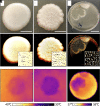The hypothermic nature of fungi
- PMID: 37130151
- PMCID: PMC10175714
- DOI: 10.1073/pnas.2221996120
The hypothermic nature of fungi
Abstract
Fungi play essential roles in global health, ecology, and economy, but their thermal biology is relatively unexplored. Mushrooms, the fruiting body of mycelium, were previously noticed to be colder than surrounding air through evaporative cooling. Here, we confirm those observations using infrared thermography and report that this hypothermic state is also observed in mold and yeast colonies. The relatively colder temperature of yeasts and molds is also mediated via evaporative cooling and associated with the accumulation of condensed water droplets on plate lids above colonies. The colonies appear coldest at their center and the surrounding agar appears warmest near the colony edges. The analysis of cultivated Pleurotus ostreatus mushrooms revealed that the hypothermic feature of mushrooms can be observed throughout the whole fruiting process and at the level of mycelium. The mushroom's hymenium was coldest, and different areas of the mushroom appear to dissipate heat differently. We also constructed a mushroom-based air-cooling prototype system capable of passively reducing the temperature of a semiclosed compartment by approximately 10 °C in 25 min. These findings suggest that the fungal kingdom is characteristically cold. Since fungi make up approximately 2% of Earth's biomass, their evapotranspiration may contribute to cooler temperatures in local environments.
Keywords: fungal evapotranspiration; fungal hypothermia; fungal thermoregulation; infrared thermography; mushroom.
Conflict of interest statement
R.J.B.C. and A.C. are cofounders of MelaTech, LLC, a biotech company dedicated to the manufacturing of fungal melanin and R&D of melanin-based biotechnologies. Johns Hopkins has applied for a patent on the Mycooler that is described in the paper.
Figures





Similar articles
-
Transfer of radioactive cesium and potassium, and water into the fruiting bodies of oyster mushrooms.Chemosphere. 2025 Jun;379:144431. doi: 10.1016/j.chemosphere.2025.144431. Epub 2025 Apr 26. Chemosphere. 2025. PMID: 40288214
-
Bacterial interactions with the mycelium of the cultivated edible mushrooms Agaricus bisporus and Pleurotus ostreatus.J Appl Microbiol. 2023 Jan 23;134(1):lxac018. doi: 10.1093/jambio/lxac018. J Appl Microbiol. 2023. PMID: 36626759 Review.
-
Cultivation of Pleurotus ostreatus and other edible mushrooms.Appl Microbiol Biotechnol. 2010 Feb;85(5):1321-37. doi: 10.1007/s00253-009-2343-7. Epub 2009 Dec 3. Appl Microbiol Biotechnol. 2010. PMID: 19956947 Review.
-
Development of nutraceutical formulations based on the mycelium of Pleurotus ostreatus and Agaricus bisporus.Food Funct. 2017 Jun 21;8(6):2155-2164. doi: 10.1039/c7fo00515f. Food Funct. 2017. PMID: 28534588
-
Caffeine metabolism during cultivation of oyster mushroom (Pleurotus ostreatus) with spent coffee grounds.Appl Microbiol Biotechnol. 2019 Jul;103(14):5831-5841. doi: 10.1007/s00253-019-09883-z. Epub 2019 May 21. Appl Microbiol Biotechnol. 2019. PMID: 31115628
Cited by
-
Evolution of Thermal Plasticity in Hymenoscyphus fraxineus During Ash Dieback Expansion in Europe.Ecol Evol. 2025 Jun 17;15(6):e71513. doi: 10.1002/ece3.71513. eCollection 2025 Jun. Ecol Evol. 2025. PMID: 40534982 Free PMC article.
-
Environmental fungi from cool and warm neighborhoods in the urban heat island of Baltimore City show differences in thermal susceptibility and pigmentation.bioRxiv [Preprint]. 2025 May 1:2023.11.10.566554. doi: 10.1101/2023.11.10.566554. bioRxiv. 2025. PMID: 37986923 Free PMC article. Preprint.
-
Reduced growth and biofilm formation at high temperatures contribute to Cryptococcus deneoformans dermatotropism.Dis Model Mech. 2025 Sep 1;18(9):dmm052141. doi: 10.1242/dmm.052141. Epub 2025 Mar 25. Dis Model Mech. 2025. PMID: 40067245 Free PMC article.
-
Underlying the early signaling and gene expression of Pleurotus ostreatus mycelia during injury response.World J Microbiol Biotechnol. 2025 Feb 27;41(3):80. doi: 10.1007/s11274-025-04296-9. World J Microbiol Biotechnol. 2025. PMID: 40011285
-
Fungal impacts on Earth's ecosystems.Nature. 2025 Feb;638(8049):49-57. doi: 10.1038/s41586-024-08419-4. Epub 2025 Feb 5. Nature. 2025. PMID: 39910383 Free PMC article. Review.
References
-
- Gates D. M., Biophysical Ecology (Springer, New York, New York, NY, 1980).
-
- Lineweaver C. H., Egan C. A., Life, gravity and the second law of thermodynamics. Phys. Life Rev. 5, 225–242 (2008).
-
- Clarke A., Principles of Thermal Ecology: Temperature, Energy, and Life (Oxford University Press, 2017).
Publication types
MeSH terms
Supplementary concepts
Grants and funding
LinkOut - more resources
Full Text Sources
Molecular Biology Databases

